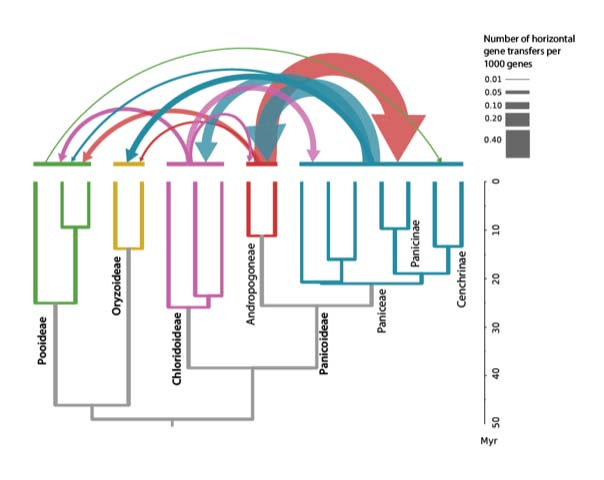
To many people, genetically engineered food feels unnatural and repellent: Fish genes in strawberries? No thanks. Opponents often call them “Frankenfoods,” suggesting that only a mad scientist could combine genes from different species in this way. But in recent decades, biologists have found that nature itself often plays fast and loose with DNA. The more we’ve looked, the more examples we’ve found where a gene from one species has made its way into another, sometimes distantly related, species. Now, new research shows how important this inter-species genetic swap meet has been in grasses, a group that includes food staples like rice, corn, wheat, and sugar cane.
Where's the evolution?
Genetic information is most often transmitted between organisms via inheritance: parental DNA is copied and passed on to offspring. This is known as vertical transmission. Horizontal transmission, on the other hand, occurs when genetic information is passed from one individual to another outside of parent/child inheritance — sort of like if you could pick up a gene for curly hair from a friend with curly hair.
Scientists used to think that horizontal transfer was rare — and that when it did happen, it was usually among viruses and single-celled organisms like bacteria. The traits that they could easily observe in larger, complex organisms seemed to always be passed through lineages of descent, never horizontally across lineages. However, as we have made advances in sequencing DNA and organizing this vast amount of data, we’ve discovered more examples of horizontal transfer and more cases in animals, plants, and fungi.
This is important to evolution because evolutionary processes act on genetic variation. Genetic variation represents the pool of traits that natural selection sifts through, favoring some and weeding out others. And horizontal transfer is turning out to be a more important source of variation than we’d previously thought. With vertical transmission alone, evolving, say, a gene that makes a plant drought resistant would always involve many generations of random mutation and natural selection. This would continue until, finally, just the right mutations happened to occur in the same lineage, producing a drought resistance gene. With horizontal transmission, however, a fully functional drought resistance gene could be passed directly from one lineage to another in a single generation. And after a gene evolves once, it could be passed to many other lineages fully formed. Horizontal transfer can increase the variety of traits that natural selection has to select among within a population. And the new research shows that in grasses, it has done just that.
This evolutionary tree shows the relationships among major groups of grasses. It shows both vertical transmission and horizontal transfer. Traits have been passed from ancestors at the root of the tree to descendants at the tips through vertical transmission. The colored arrows show horizontal transfers of genes among lineages. Of course, the vast majority of the genes the researchers studied were transmitted vertically from ancestor to descendant. But horizontal transfer happened too. And the genes that were horizontally transferred and then became established in the recipient lineages seem to have important effects. The study found swapped genes relating to traits like stress tolerance and disease resistance. Furthermore, this wasn’t restricted to wild grasses. Crop grasses that form the basis of human diets around the world carry genes that they picked up horizontally from other lineages. If you’ve had a corn tortilla or a slice of wheat bread, you’ve eaten some version of a “Frankenfood” already. We still don’t know exactly how horizontal transfer occurred in these cases — but the evidence clearly shows that it has happened.

So is this nature’s version of genetic engineering? In a way. The effects of horizontal transfer and genetic engineering are the same: a gene is copied from one species into another, potentially distantly related species. But of course, there is also a big difference: intention. Species are not trying to get particular genes. Natural selection is not trying to produce lineages with particular traits. Evolution has no intent. Genetic engineers, on the other hand, try to produce species with particular traits — mosquitoes that can’t transmit malaria, corn that requires less water, potatoes with more protein. Engineers and scientists respond to needs. Evolution does not.
Primary literature:
- Hibdige, S. G. S., Raimondeau, P., Christin, P., and Dunning, L. T. (2021). Widespread lateral gene transfer among grasses. New Phytologist. DOI: 10.1111/nph.17328. Read it »
News articles:
- A summary of the discovery from Farmers Weekly
- A deeper dive into the research from the New Scientist
- One of the scientists behind the new research explains its significance from The Conversation
Understanding Evolution resources:
- In your own words, explain the difference between vertical and horizontal gene transmission.
- What is the effect of horizontal transfer on the genetic variation in a population? How does this impact the evolutionary potential of that population?
- Review the process of natural selection. Which of the four steps on that page is most directly affected by horizontal gene transmission? Explain your answer.
- Some coverage of this research refers to plants “stealing genes from one another.” In what ways is that description accurate? In what ways is it inaccurate? Be sure to include the concept of intention in your answer.
- Advanced: Imagine you are studying a group of plants in which a drought resistance gene was passed horizontally from one lineage in the group to another distantly related lineage in the group. Other genes were transmitted vertically within the group. You use the genetic sequence of the drought resistance gene to construct an evolutionary tree for the group, and in a separate analysis you use genes involved in photosynthesis to construct an evolutionary tree for the group. Would you expect the two trees to match? Why or why not? If you expect them to differ, how would you expect them to differ?
- Teach about genetic variation and horizontal transfer: In this case study, college students compare the genomes of MRSA and its genetic cousin MSSA to locate DNA differences and mobile elements that could be expected to improve the bacterium’s resistance to antibiotics and its ability to cause disease.
- Teach about natural selection: In this classroom activity for grades 9-16, students simulate breeding bunnies to show the impact of evolution on a population of organisms.
- Teach about horizontal transfer: This news brief from 2008 for grades 9-16 explains the quirks of bacterial evolution, including horizontal transfer, that make them such a threat.
- Hibdige, S. G. S., Raimondeau, P., Christin, P., and Dunning, L. T. (2021). Widespread lateral gene transfer among grasses. New Phytologist. DOI: 10.1111/nph.17328
